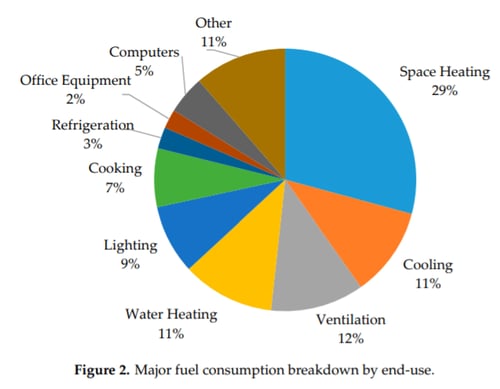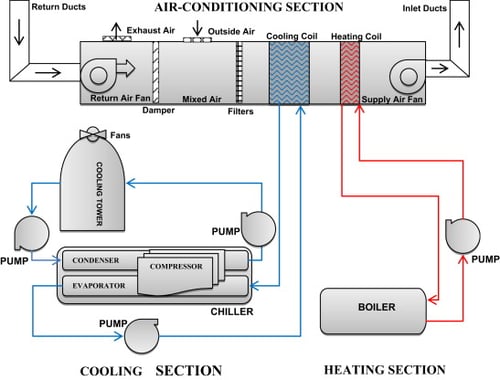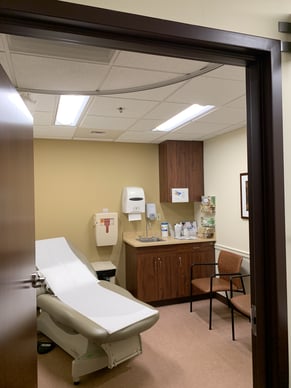Energy Efficiency | August 20, 2020
Why Healthcare Energy Efficiency is (Still) Such a Big Deal
US healthcare facilities consume, on average, 2.6 times the energy of their commercial counterparts. Lifesaving equipment, surgeries, recovery spaces and preventative and routine care simply use far more energy than processes in other industries. As a result, healthcare energy efficiency remains a vitally pressing concern in the industry.
Researchers at Missouri State University and Kettering University reexamined energy consumption in US healthcare facilities in 2019. Their discoveries – building on this 2012 study by the US Energy Information Administration – emphasize the large amounts of energy needed for healthcare today, and the opportunities for these facilities to leverage energy efficiency.
The Missouri State and Kettering University research, published in the peer-reviewed, open access journal, Energies, notes that “Healthcare facilities accounted for 4.8% of the total area in commercial buildings and consumed 210.42 billion kWh of energy (which represents 10.3% of total energy consumption in the commercial sector).” In the years since the 2012 data, we can assume some improvement in energy strategies at large hospitals, but these facilities continue to demand so much energy to run effectively that tremendous opportunities remain for improved efficiency.

Data source: MDPI
simple definitionHealthcare Energy EfficiencyHealthcare Energy Efficiency is a set of energy strategies and executions designed to lower energy use in hospitals and other healthcare facilities. These tactics can include efficiency solutions for lighting, HVAC or mechanical, security, water, refrigeration and other systems that compose the operational structure for a healthcare facility. |
Why hospitals are so inefficient
Hospitals are inefficient for several reasons: 24/7 run-hours, business activity (such as running MRI machines) and large property footprints all contribute to inefficient systems.
Additionally, one of reasons hospitals are inefficient is because they are almost always built in stages. For example, phase one and one set of buildings was built in the 1960s. A second wing was added in the 1970s, with more buildings added in the last twenty years, etc. The evolution of a hospital campus over time means the systems are not only old but usually not the same type or technology either. A best practice is to consolidate those systems wherever possible (the BMS into one system, lighting into a uniform system). This enables greater control and increased opportunity for efficiencies.
Some of the factors making hospitals inefficient can’t be immediately changed. Certain types of hospital equipment, including MRI machines or x-ray technology, require a lot of energy to operate. Until manufacturers target energy inefficiencies for those machines, there are simply no savings to be found. Similarly, most hospitals and many other healthcare facilities have long or non-stop run-hours. Again, this isn’t a factor that can be changed – ERs operate at all hours; illnesses occur year around; and babies don’t limit being born to business hours.
However, hospital operational systems – including mechanical and lighting – can be audited for energy use to uncover whether efficiency solutions are available.

Image source: Science Direct
Hospital HVAC and mechanical systems
HVAC systems in healthcare facilities are vast, complex, and unique to each property or healthcare campus. Oftentimes, they involve immense boilers and chillers, multiple air handlers, pumps, rooftop units and dozens of other equipment types.
The age of these systems can be the source of their inefficiencies. Other times, how the systems integrate – or do not integrate – can be a source of savings. A lack of sensors, data or controls information are all areas where efficiencies can be gained.
Example exam room lighting – upgraded to LED
Lighting in healthcare facilities
Lighting should never be overlooked. Unless every hallway, patient room and OR is upgraded to the latest generation of LEDs, an audit can uncover potential savings. With long run-hours, hospital and healthcare facility lighting can quickly become costly – even if it’s a smaller portion of the utility bill (on average, 9%, according to the data above).
For a large hospital campus in Illinois, our Chicago team engineered a lighting project that replaced over 38,000 fixtures. Just by updating lighting to LED, the healthcare facility is now saving over $2 million per year.
What efficiency means in hospitals and healthcare facilities
Energy efficiency is equally as important to healthcare as it is to other large commercial or industrial facilities. Efficiency leads to better operations, decreased energy costs and improved environmental impact.
Reduced operational costs due to energy efficiency projects are a huge boon to health care facilities. These savings help offset routine costs (a surge in energy consumption due to air conditioning during a summer heatwave, for example), as well as extraordinary ones. As our healthcare system – and hospitals in particular – continue to bear the brunt of the COVID-19 pandemic, energy efficiency solutions and the savings they entail are more important now than ever before.
Improving healthcare energy efficiency
Hospital and healthcare facilities managers have a variety of options available for improving energy usage in their buildings. Finance teams and hospital boards also benefit from learning how these operational improvements will impact a healthcare facility’s financial statements through annual savings. Though not comprehensive, the following list is a good starting point for such conversations:
Energy savings ideas for hospitals
- Upgrade lighting to LED
- Add smart lighting control systems
- Consider improving efficiency of motors across equipment
- Retrofit Rooftop Units (RTUs) with Variable Frequency Drives (VFDs)
- Install fan walls for Air Handlers (AHUs)
- Evaluate boilers for improved efficiency
- Integrate building automation systems for greater visibility and control
Get started on saving
It’s not always easy to implement efficiency upgrades at an active, busy hospital. Schedules, personnel, patients, and budgets can all hinder whether a healthcare facility will take on energy upgrades. But the resulting decrease in energy usage by key systems – in addition to the environmental impact and financial benefits – are reason enough to start exploring retrofits.
Taking action now decreases the cost of waiting month over month and seizes the best available utility incentives. There no time like the present to start improving healthcare energy efficiency.
Related Posts
Discover more content and insights from Mantis Innovation

The Cost of Inaction: Why Businesses Should Act Now on Energy Efficiency
In today's fast-paced business environment, the financial and operational losses businesses incur by delaying energy efficiency improvements, the "cost of inaction," is more relevant than ever.

In today’s AI era, human intelligence is the key to data center facility and energy optimization
Nowhere else in modern industry do artificial and human intelligence converge with such transformative potential as in the world of data centers. As AI's extraordinary growth accelerates demand for

Your Guide to LED Lighting for Business and Commercial Buildings
Never to be underestimated, LED lighting and well-designed lighting retrofits and upgrades offer businesses big improvements like reduced energy costs, reduced emissions, and improved working

Five Trends Driving Data Center Facility Energy Optimization
Today’s digital economy, commercial and industrial digitalization, and the recent explosion in artificial intelligence and machine learning (AI/ML) powered computing are driving massive growth in
